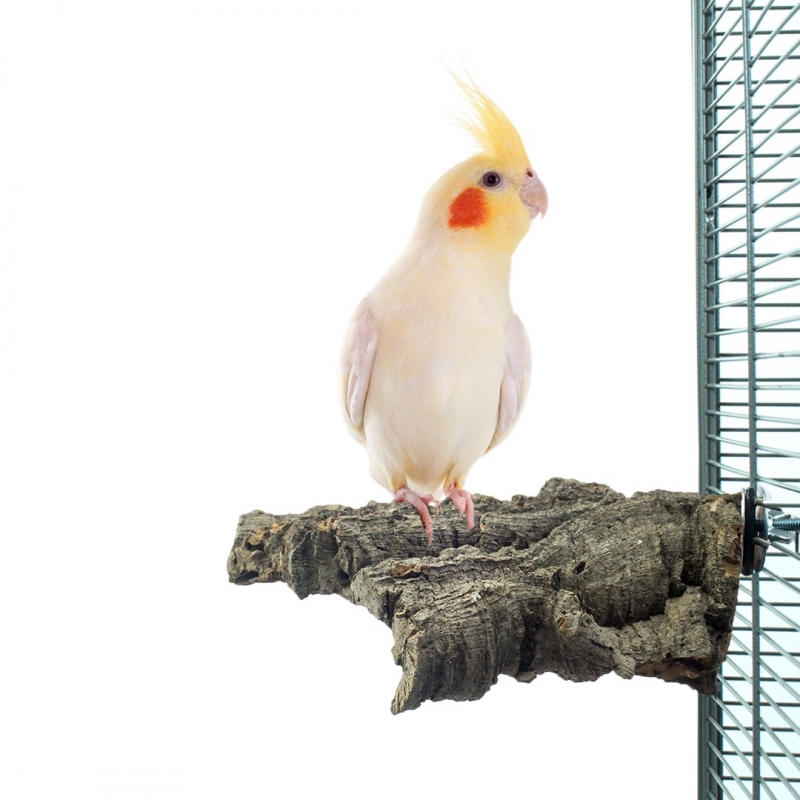
Cockatiel



Cockatiel
Name Dutch: Cockatiel
Scientific name: Nymphicus hollandicus
Origin: Australië
Age: With good care 15-20 years, sometimes even older.
Height: About 34 cm head to tail tip.
Birth: Egg laying (Average 4 to 7 eggs per nest).
These hatch after about 19 to 21 days.
Activity: Day active
Legislation: No CITES.
Other legislation: Must be at least 51 days old before they can leave their parents.
Climate: From a desert climate to a (sub)tropical climate.
Stay: A large cage or aviary with a loose java tree or playground.
Minimum size: Minimum dimensions 120x60x70cm. ''The bigger the better''.
Food: (70%) Pellets and/or Nutri-Berries in combination with (30%) seeds, fruit, vegetables and nuts. Always provide stomach grit with a seed mixture.



Description
The cockatiel has a misleading name, it is not actually a parakeet. A cockatiel is a small cockatoo, and like a cockatoo, it has a nice large crest that it can lay flat on its neck and prop it up. The cockatiel is native to Australia and lives in groups. When Cockatiels eventually mature, the difference between male and female is clearly visible. Cockatiels are intelligent and eager to learn and need plenty of toys and challenges. It is therefore recommended that they be stimulated every day to play and forage for food, for example with foraging toys, learning tricks and attention.
Taming a cockatiel can be a uchallenging and requires a lot of patience. However, when they are tame they are even nicer pets than they already are. So it is definitely worth taking your time for this. It is best to first look for what your cockatiel really likes. One likes fruit and the other likes nuts. Have you found something that your cockatiel really likes? Then go see if you can lure him to eat the treats from your hand. This way the cockatiel will slowly become less afraid of your hand and he / she will come to you faster and faster.

Difference Between Man & Woman
The difference between an adult male and a female cockatiel (wild color - as it occurs in the wild) is easy to see. The male cockatiel has brighter colors than the female. The female has stripes on the underside of the tail feathers and wing feathers.
With young cockatiels it can sometimes be difficult to tell whether it is a male or a female. This is because the young cockatiels all look like female. After about 6 months, after the first moult, the sex will be visible. In some cases where the cockatiel no longer has the normal wild color but a different color, it is still difficult to see after the first moulting period whether it is a male or a female. Sometimes, in combination with behavior and appearance, a statement can be made about the sex of the cockatiel.
We see that male cockatiels are real macho men. They can parade with the crest up, make more noise and whistle along with all the tunes. Females are a lot calmer and don't show the macho behavior that the male cockatiel exhibits. Nice whistling is not really in it and we see more screaming than whistling. It is also said that females will show aggression faster than a male. Even though this is relative to the bird and can therefore differ per bird.
If there is still uncertainty about the sex of the bird: a DNA test can always be done in which it can be determined from a little blood or a pulled feather whether we are dealing with a male or a female cockatiel.


Reproduction
Female cockatiels are sexually mature at 6 months to 1 year. But it is not recommended to start breeding at that time. Rather wait until a female cockatiel is around 1,5 years old. If a cockatiel starts breeding too young, this can cause problems. This can cause problems not only for the bird itself, with laying and breeding, but especially when raising the young.
If a pair of cockatiels decides to lay eggs, the female cockatiel will lay about 4 to 7 eggs at a time.
Both parents assist in the incubation process and alternate in the task of caring for the eggs.
After about 19 to 21 days of incubation, it is time for the fry to hatch.

Jongen
The young of cockatiels are born helpless and are completely dependent on their parents during the first period of life. When the young are about 5 weeks old, they take off their legs/'wings' and leave the nest to explore the world. They are fed by the parents for the first 2 to 3 weeks after fledging. You also see during that period that they increasingly look at what the parents eat and whether they can already eat it themselves.
After 51 days, the cockatiels are officially allowed to leave the parents according to the ''Animal Holders Decree''. However, it is important to check whether this is actually possible. Sometimes it is necessary to leave the bird with the parents for another week. Removing the bird earlier than 51 days is strictly not recommended and is therefore prohibited by law.


Nutrition
Provide your cockatiel's diet in the following composition: (70%) Pellets and/or Nutri-Berries in combination with (30%) seeds, fruit, vegetables and nuts. Always provide stomach grit with a seed mixture. The birds should always have access to food, but make sure you don't give too much of seeds and food where they can eat picky. They will then only eat the tasty things. A cockatiel should not get too much fat. Pellets contain everything the bird needs in the right composition. Nature also has to find a cockatiel for its food itself. So don't throw everything together in a food bowl, but let them make an effort. For example, hide the nutrients in a foraging toy. In this way you continue to challenge your bird to actively search for food and stimulate its natural behavior.

Cockatiels Cage
The Cockatiel can be kept indoors in a cage, provided the cage is spacious enough. So give them a spacious cage with preferably horizontal bars, so that the animals can climb through the cage better. It is especially important that the cage is wide so that they can fly back and forth. A high cage is less relevant, because they don't fly from top to bottom. However, the cage should be high enough, if it is a low cage, it should be on a cupboard and not on the floor.
Sufficient perches must be available. These are best placed at different heights and distances. The perches should be of different thicknesses, preferably natural perches (branches). In this way, the legs are better trained and the nails wear out in a natural way. There is also more grip for the birds on natural branches.
Toys should of course not be missing! A cockatiel alone in the cage will soon get bored, so it is preferable to keep them in pairs. Provide sufficient demolition toys, because gnawing and breaking is natural behavior and should be stimulated. In addition, foraging toys are important, in nature a cockatiel is looking for food for a large part of the day. This natural behavior can be stimulated with foraging toys.
Many articles have been added to the bottom of the cage in recent years. So there is a choice of various types of ground cover. Each type has its pros and cons. A cage with a natural design and appearance is of course the best and most beautiful. For example, there is Discovery Bedding from Back Zoo Nature.

More info?
Have you become curious about the cozy crested cockatiel? Do you want more information about this? Our bird workers are happy to help you! So come by soon to see what we have for sale. We always sell cockatiels with a warranty. If there is something wrong, after this period you can of course always contact us!



